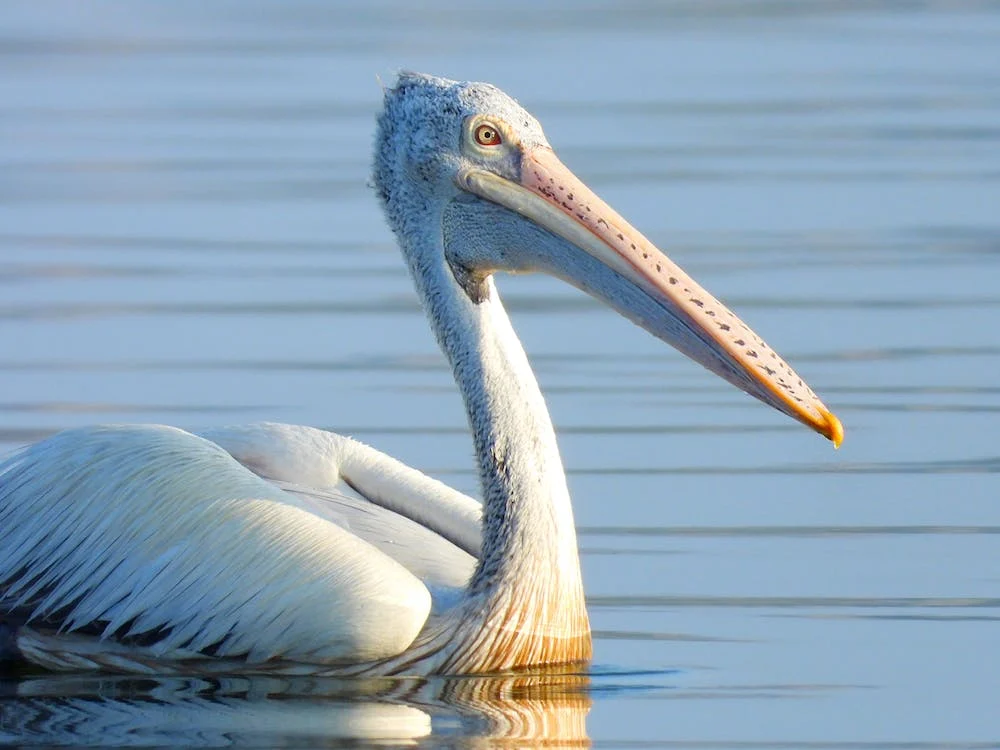It is a waterbird boasting a huge bill with throat pouch. It is one of the largest flying birds in the world that thrives in Africa’s shallow swamps. During their flight, they show dark flight feathers, contrasting their white wings. These birds are often noticed fishing with other birds from their species, swimming in circles to round up their prey, and scooping them whole into their pouch.
Read further to know more about the Great White Pelican.
What is a Great White Pelican?
The Great White Pelican (Pelecanus onocrotalus) is one of the largest flying birds in the world. Yet, it has the abilities of various birds, such as swimming and long flights. This bird is renowned for the gular pouch in its bill. It has strong, short legs equipped with webbed toes, enabling it to propel from the water or take off from the water’s surface. These birds are tenacious flyers, and their flocks follow the V-formation when travelling to decrease drag for all the members.
Its seven levels of classification are as follows:
Kingdom: Animalia
Phylum: Chordata
Class: Aves
Order: Pelecaniformes
Family: Pelecanidae
Genus: Pelecanus
Species: P. onocrotalus
Great White Pelican Physical Description
Great White Pelican males grow slightly larger than the females. The former grows around 14.5 inches or 175 centimeters while the latter reaches 12 inches or 145 centimeters in length. With their size variation, males also have longer bills compared to females. Both sexes have massive wingspan, measuring up to 3 meters wide.
These birds have mainly white plumage, except for their black wing edges. Their legs are short and pinkish, with webbed feet. A bare pink or yellow facial patch surrounds their eyes. Depending on the breeding season, their throat or chest may vary in color, ranging from pink to yellow, or orange coloration.
Great White Pelicans’ distinct bills have a bluish top and yellow underneath. Their gular pouch is located at the bottom of their beak, which has a red band at the center and ends with a little red hook.
Their long bills are not a show-off, as they utilized them to scoop fish from the water. It is stretchy that it can hold up a few liters of water. Their bills bow out underwater forming a large pouch that catches the fish and water. When they lift their head, their gular bag squeezes the water out but keeping the prey which they swallow whole.
Where can they be spotted?
Great White Pelicans can be found in Asia, Europe, and Africa. However, their resident population is situated in the sub-Saharan countries of Africa. They have migratory counterparts that thrive from Eastern Europe to Kazakhstan during the breeding season and move to northeast Africa, Iraq, India and southern Vietnam during the winter season.
In Europe, they can be found in marshes, lakes, deltas, and swamps, or locations where there ample amount of reed beds and grasses for nesting. Meanwhile, in Africa, they occur in lowland alkaline of freshwater lakes. They need warm and shallow water for them to catch prey using their ‘scooping’ technique effectively.
Interesting Facts You Should Know About the Great White Pelican
Great While Pelicans thrive, breed, feed, migrate in large colonies. They usually fish for food at around 8 to 9 in the morning then rest on sandbars, small islands, preening their wings, bathing, and sleeping. These birds are carnivores, eating fish, and other small invertebrates. In Europe, they prefer to eat carps while their African counterpart loves to eat cichlids.
These birds bathe by ducking their bodies and heads into the water simultaneously flapping their wings. Often, when the water is hot, they gape or spread their wings to cool down. Large groups of great white pelicans may also gather at traditional roosts. While they love to roost on the ground, they are sometimes seen perching in trees.
Great White Pelicans are monogamous birds, which develops life-long bonds with their partners. When breeding season comes, the male becomes pretty territorial, either clapping, bowing, gaping his bill and may engage in fights should another male comes to near.
Their breeding season starts in April to May in Europe, though, in Africa, they generally breed all year round. Courtship displays include males showing the vibrant colors on their gular pouch and their head crest. The formation of a pair, selection of the nest site, and building of the nest can happen from a few hours to a week. They use sticks or bare rocks from the ground in building their nest. They nest with the colony, usually along swamps, lakes, or islands.
Great White Pelican females lay 1-2 eggs, which she solely incubates for more or less a month. Their chicks will fledge at around 65-75 days and reach their sexual maturity in three to four years.
Their species is not under threat. However, their other pelican cousins are, mainly due to flooding, pollution, diseases, destruction of their habitat, and breeding site disturbance. Once a colony is distrubed, they will leave the area and will never come back.
WILDLIFE PARKS AND RESERVES WHERE THIS SPECIES IS FOUND:
BOTSWANA
SOUTH AFRICA
NAMIBIA
ZAMBIA
ZIMBABWE
BOTSWANA BIRDS | SOUTH AFRICA BIRDS
NAMIBIA BIRDS | ZAMBIA BIRDS | ZIMBABWE BIRDS

